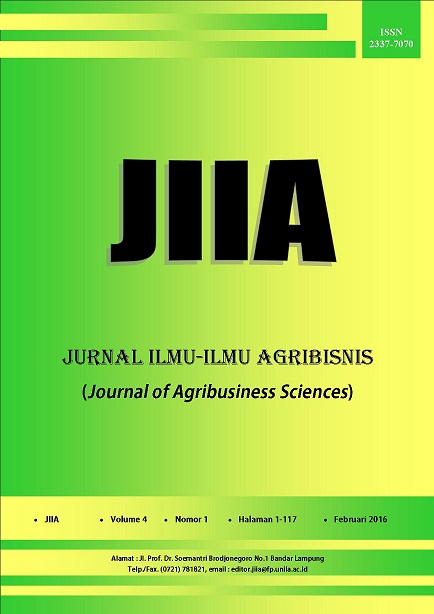ANALISIS FINANSIAL DAN STRATEGI PENGEMBANGAN NANAS MADU DI KABUPATEN LAMPUNG TIMUR
DOI:
https://doi.org/10.23960/jiia.v4i1.1209 Abstract View: 1821
Abstract View: 1821
Abstract
This research purposes to: (1) analyze the farming financial feasibility of honey pineapple, and (2) know the priority strategies that must be done for the farming development of honey pineapple. This research was located in East Lampung District which was chosen purposively. Respondents taken were 67 farmers. The first purpose was analyzed quantitatively by financial analysis (Net B/C, NPV, IRR and Payback Periode) using compounding factor (CF) and discount factor (DF) 14%. The second purpose was analyzed descriptively by SWOT analysis. The result showed that the farming of honey pineapple in East Lampung is feasible and profitable. Financially the farming was feasible because the value of NPV and Net B/C were bigger than 1, and the value of IRR was bigger than interest rate. The priority strategies for Farming Development of honey pineapple were ; (1) utilizing fertile and vast field to increase the production for market domination (2) utilizing the easily available production facilities and suitable climate to increase the production, (3) producing good quality of goods to dominate the market.
Key words : developments strategic, financial analysis,and honey pineappleDownloads
Downloads
Published
How to Cite
Issue
Section
License
Authors who publish with this journal agree to the following terms:
Authors retain copyright and grant the journal right of first publication with the work simultaneously licensed under a Creative Commons Attribution License that allows others to share the work with an acknowledgement of the work's authorship and initial publication in this journal.
Authors are able to enter into separate, additional contractual arrangements for the non-exclusive distribution of the journal's published version of the work (e.g., post it to an institutional repository or publish it in a book), with an acknowledgement of its initial publication in this journal.
Authors are permitted and encouraged to post their work online (e.g., in institutional repositories or on their website) prior to and during the submission process, as it can lead to productive exchanges, as well as earlier and greater citation of published work (See The Effect of Open Access).














